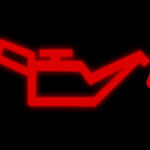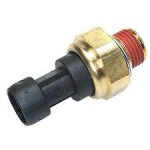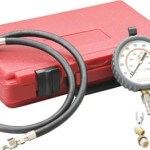Oil light on
Oil light is on
 All engines are equipped with an oil pressure sensor, also called a sending unit. If the vehicle has a gauge, the sending unit sends a varying voltage to the gauge. But if the vehicle just has an oil light, the sending unit lights the light only when oil pressure is below specifications—usually less than 7-psi. That’s why the oil light is on at startup when the oil pressure hasn’t yet built up to spec. Once the pressure reaches the minimum level, the light goes out.
All engines are equipped with an oil pressure sensor, also called a sending unit. If the vehicle has a gauge, the sending unit sends a varying voltage to the gauge. But if the vehicle just has an oil light, the sending unit lights the light only when oil pressure is below specifications—usually less than 7-psi. That’s why the oil light is on at startup when the oil pressure hasn’t yet built up to spec. Once the pressure reaches the minimum level, the light goes out.
What if the oil light doesn’t go out?
If the oil light stays on, it flickers, or the oil light flashes, there can be three causes;
• The sending unit has developed a leak (externally or internal) and is outputting a bad signal
• The engine is dangerously low on oil
• The engine really is low on oil pressure.
How to test the oil sending unit
If your oil light stays on, a shop would remove the oil sending unit and connect an oil pressure gauge to get an exact reading.
You probably don’t own or have access to a gauge, so your best bet is to try a new oil sending unit. They’re pretty cheap, less than $20. But you usually need a special socket to swap out the sensors. Most auto parts stores will rent the socket. Or you can click here to buy one. If the oil light goes out and stays out with a new sensor, you’ve found the cause and fixed the problem.
However, if the oil light stays on even with a new sensor, you’ve got a far more serious problem. The low oil pressure can be due to a worn oil pump, worn bearings, a clogged oil pickup screen, or an oil leak somewhere in the system. A shop would install a pressurized tank of oil and connect it to the oil pressure sending unit port. Then they’d remove the oil pan and examine the drip rate from the bearings. Excessive drip would indicate worn bearings.
Don’t automatically replace the oil pump to correct an oil light on situation
Most DIYers, on the other hand, start by replacing the pump. WRONG! First off, if the pump has suffered that kind of wear, so have all the other internal engine parts. A worn pump is a sign of poor maintenance. So don’t get your hopes up that the new pump will fix your low oil pressure problem. Of course, if you don’t have the equipment to diagnose the problem and you know how to drop the oil pan and replace the pump, you have little to lose but time and money. Just don’t forget to pack the pump with grease to prime it. That’s the most common DIY mistake. A dry pump will not prime itself.
If you determine that the low pressure is caused by excessive bearing clearances, you’ll see lots of bad advice on the internet to just use a higher viscosity oil. A higher viscosity oil may get you better oil pressure at idle. But don’t kid yourself, you haven’t solved the main problem. In fact, you’ve made it worse. Heavier oil doesn’t flow as fast, so it picks up more heat and stays in contact with metal parts longer, which causes accelerated wear. So your light may be out, but you’re destroying your engine at a faster rate. Read this post on what other issues are involved when using the wrong viscosity oil
Instead of thinking you can fix this with heavier oil. you’ll have to make the decision on whether to rebuild or replace the engine. Whichever you decide, use this as a learning experience that poor maintenance always causes excessive wear. You never save money by skimping on oil changes.
Finally, don’t confuse an oil pressure light with an oil LEVEL light. Few cars have oil level sensors. If yours does, it means the engine is dangerously low on oil. Pulling over and turning off the engine should be your first course of action when either light comes on. If the oil level is low, fill it up to the full line. The light should go out. If it does, you can keep driving. But if the light stays on, call a tow truck. Driving with the oil light on can cause total engine destruction.
© 2012 Rick Muscoplat
Posted on by Rick Muscoplat

